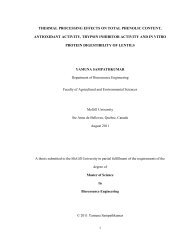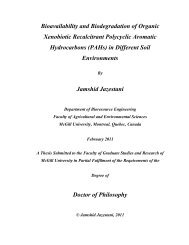Postharvest treatments to reduce chilling injury symptoms in stored ...
Postharvest treatments to reduce chilling injury symptoms in stored ...
Postharvest treatments to reduce chilling injury symptoms in stored ...
Create successful ePaper yourself
Turn your PDF publications into a flip-book with our unique Google optimized e-Paper software.
Figure 2.3 : Whitish gray lesion on mango Figure2.4: Typical anthracnose lesion on mango<br />
leaf caused by Pestalotiopsis. leaf caused by Colle<strong>to</strong>trichum gloeo-<br />
mangifera (Litz, 1997). sporioides (Litz, 1997).<br />
For fresh mango fruit <strong>to</strong> be accepted by market, it has <strong>to</strong> be treated <strong>to</strong> ensure that it<br />
is free of fruit flies. Dis<strong>in</strong>festations can be done by chemical fumigation, or by non-<br />
chemical treatment, which consists of heat<strong>in</strong>g the fruits <strong>to</strong> specific temperature and<br />
ma<strong>in</strong>ta<strong>in</strong><strong>in</strong>g this temperature for a def<strong>in</strong>ed period of time which could kill fly larvae and<br />
eggs. Vapour heat treatment (VHT), forced hot air treatment (FHAT), and hot water<br />
(HW) immersion are commonly used heat <strong>treatments</strong> for mango fruit (Esguerra and<br />
Lizada, 1990).<br />
2.1.3 Harvest<strong>in</strong>g<br />
A good system of transport is necessary <strong>to</strong> develop an <strong>in</strong>dustry or market; it means<br />
a channel by which the consumer receives the commodity under best condition with<br />
m<strong>in</strong>imum cost. Fruits are usually very perishable and mango is one of them. Their market<br />
value is affected if they receive any slight <strong><strong>in</strong>jury</strong> dur<strong>in</strong>g their pick<strong>in</strong>g, packag<strong>in</strong>g, and<br />
s<strong>to</strong>ck<strong>in</strong>g <strong>in</strong> transit or on retail display. Mangoes are usually harvested green. Harvest<strong>in</strong>g<br />
usually takes place after 15-16 weeks of fruit set when they are physiologically matured<br />
(Lakshm<strong>in</strong>arayana et al., 1970). Later harvest<strong>in</strong>g may result <strong>in</strong> uneven ripen<strong>in</strong>g, and can<br />
lower sugar <strong>to</strong> acid ratio. There is no particular parameter for judgment of fruit maturity;<br />
it depends on mango type, variety, production conditions, and location. Physical,<br />
chemical, and physiological parameters are used <strong>to</strong> def<strong>in</strong>e the maturity stage for<br />
7









